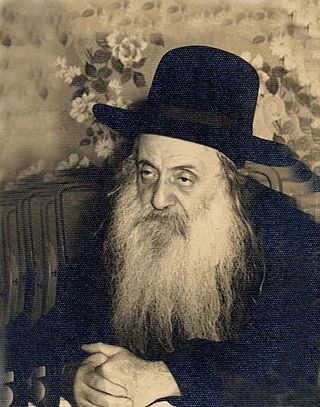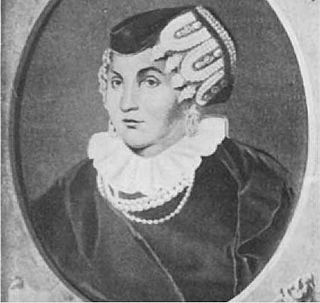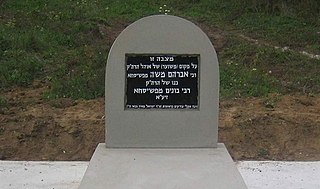Ger is a Polish Hasidic dynasty originating from the town of Góra Kalwaria, Poland, where it was founded by Yitzchak Meir Alter (1798–1866), known as the "Chiddushei HaRim". Ger is a branch of Peshischa Hasidism, as Yitzchak Meir Alter was a leading disciple of Simcha Bunim of Peshischa (1765–1827). Before the Holocaust, followers of Ger were estimated to number in excess of 100,000, making it the largest and most influential Hasidic group in Poland. Today, the movement is based in Jerusalem, and its membership is estimated at 11,859 families, as of 2016, most of whom live in Israel, making Ger the largest Hasidic dynasty in Israel. However, there are also well-established Ger communities in the United States and in Europe. In 2019, some 300 families of followers led by Shaul Alter, split off from the dynasty led by his cousin Yaakov Aryeh Alter.

Simcha Bunim Bonhardt of Peshischa also known as the Rebbe Reb Bunim was the second Grand Rabbi of Peshischa as well as one of the key leaders of Hasidic Judaism in Poland. The main disciple of Yaakov Yitzchak Rabinowicz, from 1813 to 1827, he led the Peshischa movement of Hasidic thought, in which he revolutionized 19th-century Hasidic philosophy by juxtaposing the rationalistic pietism of German-Jewry with the spiritual nature of God defined by the Hasidic movement.

Amshinov is a Jewish Hasidic dynasty founded in the town of Mszczonów, Poland, by Yaakov Dovid Kalish, the son of Israel Yitzhak Kalish. Amshinov is a branch of Warka Hasidism, which in part is a branch of Peshischa Hasidism, as Israel Yitzhak Kalish was a leading disciple of Simcha Bunim of Peshischa (1765-1827).
Biala is a Hasidic dynasty originating from the city of Biała Rawska, where it was founded by R. Yaakov Yitzchak Rabinowicz (II). Biala is a branch of Peshischa Hasidism, as R. Yaakov Yitzchak Rabinowicz (II) was the great-grandson of R. Yaakov Yitzchak Rabinowicz, the first Peshischa Rebbe. The dynasty was originally spread throughout many towns in Poland, often taking the names of said towns. However, after the Holocaust, the name "Biala" become synonymous with the entire dynasty. Today the dynasty is mostly concentrated in Israel, America and Switzerland.

Mezhbizh is the name of the town of Medzhybizh in the present Ukraine which is significant as both the source of a Hasidic dynasty that bears its name and as a symbolic name for the roots of Hasidism.
Mordechai Yosef Leiner of Izbica known as "the Ishbitzer" (1801-1854) was a rabbinic Hasidic thinker and founder of the Izhbitza-Radzyn dynasty of Hasidic Judaism. He is best known for his work Mei Hashiloach.

Kotzk is a Hasidic dynasty originating from the city of Kock, Poland, where it was founded by Menachem Mendel Morgenstern (1787–1859). Kotzk is a branch of Peshischa Hasidism, as Menachem Mendel Morgenstern was the leading disciple of Simcha Bunim of Peshischa (1765–1827). Following Simcha Bunim's death he led the divided Peschischa community, which he eventually incorporated into his own Hasidic dynasty. Kotzk follows a Hasidic philopshy known for its critical and rationalistic approach to Hasidism and its intense approach to personal improvement which is based on a process of harsh constructive criticism and total transparency of self. Kotzk is closely connected to other branches of Peshischa Hasidism such as Ger and Aleksander and is currently based out of Jerusalem.

Shmuel Bornsztain, Hebrew calendar, also spelled Borenstein or Bernstein, was the second Rebbe of the Sochatchov Hasidic dynasty. He was known as the Shem Mishmuel by the title of his nine-volume work of Torah and Hasidic thought. He was a leading Hasidic thinker in early 20th-century Europe and a Rebbe to thousands of Hasidim in the Polish cities of Sochaczew (Sochatchov) and Łódź.

Israel Yitzhak Kalish of Warka (Yitzchok of Vurka) (1779–1848) was the first hasidic rebbe of Warka.
Yaakov Yitzchak Rabinowicz of Peshischa also known as the Yid Hakudosh or the Yehudi was the founder and first Grand Rabbi of the Peshischa movement of Hasidic philosophy, and an important figure of Polish Hasidism. The leading disciple of Yaakov Yitzchak of Lublin, the Yehudi preached an "elitist" approach to Hasidism, in which he parred traditional Talmudic learning with the highly spiritual Kavanah of Hasidism. He encouraged individuality of thought, which brought his movement into conflict with the Hasidic establishment. Nevertheless, several of his teachings would go on to influence large percentages of modern Hasidism. Following his death in 1813, he was succeeded by his main disciple Simcha Bunim of Peshischa, who increased his movement's influence tenfold. The Yehudi is the patriarch of the Porisov and Biala Hasidic dynasties.
Dinov is the name of a Hasidic dynasty, descended from Rabbi Tzvi Elimelech Spira of Dinov, also called "the Bnei Yisaschar" after his popular work: בני יששכר [Bene Yiśaśkhar]. Dinov is the Yiddish name of Dynów, a town in southern Poland, in the historic region of Galicia.

Temerl Bergson was a Polish Jewish businesswoman. She was a supporter of Jews living in Warsaw and patroness of the Hasidic movement in Poland. She was renowned for her largesse in her philanthropy toward Polish Hasidic leaders and tzadikim, and was said to have "distributed money like ashes". Referred to as the "Doña Gracia of Hasidism", she is credited with the success of the Hasidic movement in Poland in the early 19th century.
Rabbi Tsvi Hirsh Bonhardt, also known as the Maggid of Voydislav, was an 18th-century German-born Polish preacher and rabbi.

Avraham Moshe Bonhardt of Peshischa also known as the Illui Hakudosh was the contested third Grand Rabbi of Peshischa, succeeding his father R. Simcha Bunim Bonhardt of Peshischa, after his father's death in 1827. He led the less radical sect of Peshischa for two years, until his death in 1829, after which his followers adopted R. Israel Yitzhak Kalish of Vurka as his successor.

The Meisel family is a distinguished Bohemian rabbinic family originally from Prague, who descend from Yitskhak Eizik Meisels, a paternal 10th generation descendant of the Exilarch, Mar Ukba. From the early 16th century and onward, members of the family such as Mordecai Meisel achieved great economic prominence in Prague, becoming one of the wealthiest Bohemian Jewish families. It was also during this time, that a branch of the family descending from Simcha Bunim Meisels (1545-1624) immigrated to Kraków, Poland due to rising Antisemitism in Bohemia. In Poland the family produced several rabbinic scholars, such as Dow Ber Meisels and Moses Bonems-Meisels. Among the families descendants are: Shabbatai HaKohen, Yitzchak Yaacov Reines, Alexander Sender Shor, as well as the Peshischa, Sulitza, Ropshitz, Bobov, Biala, Kretshnif, and Kotzk Hasidic dynasties.
Tzvi Hersh Mordechai Bonhardt of Peshischa-Vurka was a 19th-century Polish Hasidic Rebbe and scholar who headed a Hasidic court in Przysucha.
Vurke is a Hasidic dynasty originating from the city of Warka, Poland, where it was founded by Israel Yitzhak Kalish (1779–1848). Vurka is a branch of Peshischa Hasidism, as Israel Yitzhak Kalish was a leading disciple of Simcha Bunim of Peshischa (1765–1827). Following Simcha Bunim's death, he led a part of the divided Peschischa community, in Przysucha, later incorporating the community into his own Hasidic dynasty based in Warka. Like the other branches of Peshischa Hasidism, such as Kotzk and Ger, Vurka is known for their rationalistic and individualistic approach to Hasidism.
Hasidic Judaism in Poland is the history of Hasidic Judaism and Hasidic philosophy in Poland. Hasidic Judaism in Poland began with Elimelech Weisblum of Lizhensk (Leżajsk) (1717-1787) and to a lesser extent Shmelke Horowitz of Nikolsburg (Mikulov) (1726-1778). Both men were leading disciples of Dov Ber of Mezeritch (Medzhybizh), who in part was the successor to the Baal Shem Tov who founded Hasidic Judaism in Western Ukraine. Today, a sizable portion of contemporary Hasidic Judaism and Hasidic dynasties trace their genealogical and ideological origin to Polish Hasidism.

Hasidic Judaism in Lithuania is the history of Hasidic Judaism and Hasidic philosophy in Lithuania and parts of modern-day Belarus. Hasidic Judaism in Lithuania began with R. Aaron Perlow of Karlin (Karalin) (1736–1772), R. Menachem Mendel of Vitebsk (1730?–1788) R. Shneur Zalman of Liadi (Lyady) (1745–1812) and to a lesser extent R. Hayim Haykl of Amdur (Indura), all of whom were disciples of R. Dov Ber of Mezeritch (Mezhirichi), who in part was the successor to the R. Israel Baal Shem Tov who founded Hasidic Judaism in Western Ukraine. In its earliest years, Lithuanian Hasidism suffered immense persecution by the Lithuanian Misnagdic rabbinate, who attempted to ban and excommunicate Hasidism on several occasions in Lithuania beginning with R. Elijah b. Solomon Zalman of Vilna (1720–1797), who was the earliest disseminator of anti-Hasidic thought which flourished in Lithuania.










